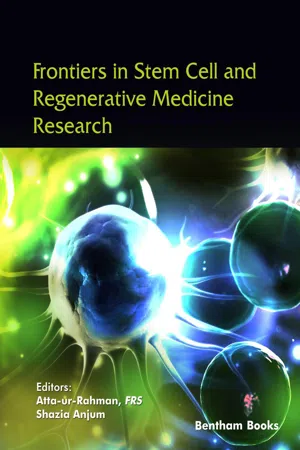Insights into Exogenous, Endogenous and Combination Therapies of Neural Stem Cells in Spinal Cord Injury
Hunaid Hasan1, *, Ping Wu2 1 Department of Neurology – Clinical Neurophysiology NYU Langone Medical Center 301 E. 17th Street, Suite 1534 New York, 10003, USA
2 Department of Neuroscience and Cell Biology University of Texas Medical Branch 4.212B Research Building 17 Galveston, Texas, 77555, USA
Abstract
Advancements in the understanding of spinal cord injury (SCI) and repair have taken great leaps in the past decade. Although understanding has evolved significantly there continues to be major limitations in the clinical interventions available for patients with spinal cord injuries. Exogenous stem cells (ExNSC) have progressed to human clinical studies, but have limitations due to ethical issues, technique and long term outcomes. However, the use of ExSCs through a stimulatory effect on growth factors, cytokine production and neurotrophic factors post injury may be beneficial. Bone marrow derived stem cells, mesenchymal stem cells, embryonic stem cells, umbilical cord stem cells, adipose derived stem cells, NSCs, Schwann cells grafts and olfactory ensheathing cells have been various types of exogenous cell types and techniques used in SCIs. The role of endogenous stem cells (eNSCs) in SCI has been promising, but still requires better lineage analyses to fully understand the responses of NSCs after SCI. It has been demonstrated that there exists a bidirectional interaction within the neuro vascular system forming the neuro vascular niche. Purinergic receptor activation was found to alter the intrinsic properties of the ependymal stem/progenitor cells enhancing regulation of proliferation, differentiation and lineage specification after a SCI. Therapies have been described using nervous tissue in combination with various synthetic bridges to overcome the structural barriers of regeneration through bypassing the injured area. More recently, newer techniques such as electrical stimulation have been described to stimulate mature neuronal differentiation. Various groups have emphasized that the glial scar is counter productive. Anderson et al. have shown the beneficial effects of a chronic glial scar in neural tissue preservation after SCI. Moreover, they have demonstrated higher levels of chondroitin sulfate proteoglycans in injured spinal cords independent of the glial scar. In sum, we have reviewed the previous and current literature on NSC and SCI to address the neurobiological utility of NSCs in spinal cord injury.
Keywords: Clinical Neurology, Cytokine, Electrical Stimulation, Electroacupuncture, Endogenous Neural Stem Cell, Exogenous Neural Stem Cell, Genetic Fate Mapping, Glial Scar, Growth Factor, Induced Pluripotent Stem Cell, Neural Stem Cell, Neurovascular Niche, Oligodendrocyte Ensheathing Cells, Progenitor, Purinergic Receptors, Schwann Cell Transplantation, Spinal Cord Injury, Stem Cell, Transplantation, Treatment, Transcription Factor.
* Corresponding author Hunaid Hasan: Department of Neurology – Clinical Neurophysiology NYU Langone Medical Center 301 E. 17th Street, Suite 1534 New York, 10003, USA; Tel: +17348588947;
E-mails: [email protected], [email protected] INTRODUCTION
Advancements in the understanding of spinal cord injury (SCI) and repair have taken great leaps in the past decade. The greatest challenge in SCI research has been the translation of what is known at the basic science level, and applying it to the clinical setting. Although, the understanding of the molecular basis of SCI has become more cogent, the therapeutic options continue to be limited. Although neural stem cells (NSCs) have been studied for over a decade, they continue to be at a translational research stage. Initially, exogenous stem cells (ExSCs) were an exciting breakthrough. However due to various reasons discussed below their clinical application as independent interventions has started to diminish. Recently, endogenous stem cells (eNSCs) have become more of an interest in SCI. Nature's endogenous process of healing spinal cord injuries was once thought to be counterproductive. However, as discussed below there has been evidence to suggest on the contrary. In sum, the function of eNSCs has been encouraging, and could help intervene in altering this natural process of healing. Further, its translation into clinical practice could improve the quality of life for numerous patients affected by SCIs.
SPINAL CORD INJURY
Epidemiology
Epidemiologically, SCI has been and continues to be a huge burden to society. Some reports find the incidence to be as low as 8 and as high as 246 cases per million depending on political, geographical, sociological and economic differences [1-4]. The mean age has increased from 28.3 years in the 1970s to 37.1 years surveyed in 2005-2008. Most concerning has been the epidemiological age group affected. As the majority affected have been in their peak productive years of their lives [5]. Also, more than 50% of SCIs affect the cervical region of the spinal cord, which is more likely to cause total body paralysis [6-8].
Mechanism of SCIs were either traumatic or nontraumatic [3]. Traumatic causes in young adults (age 15-29 years) were motor vehicle accidents (50%), violence (12%) and sport-related injuries (10%) [7, 9, 10]. Traumatic causes in the elderly (age >65 years) were mainly accidental falls [8-12]. Non-traumatic causes in both age groups were congenital and inflammatory spinal cord disorders, tumor compression, vascular ischemia vertebral spondylosis [13].
Pathophysiology
Primary Phase
SCI has been categorized into primary and secondary phases [14, 15]. The primary phase occurs due to compression and contusive injury resulting in shearing, laceration and stretching of the spinal cord. This exerts forces causing disruption of axonal function [16, 17]. It was suggested that at this stage full transection of the spinal cord was rare. There was sparing of demyelinated axons found at the subpial rim [17-21]. Animal models suggest that a minimum of 10% preservation of original axons could lead to significant neurological recovery [22, 23].
Secondary Phase
The pathophysiology of the secondary phase injury was directly proportional to the injuries occurring in the primary injury phase [17]. This phase was marked by a negative environment for neuronal regeneration [17]. The pathophysiology was marked by various processes such as ischemia, excitotoxicit...
